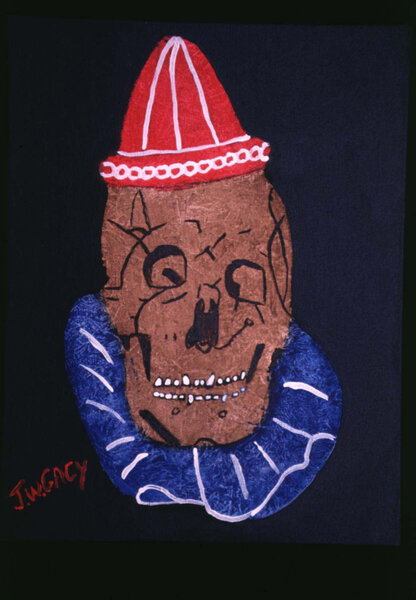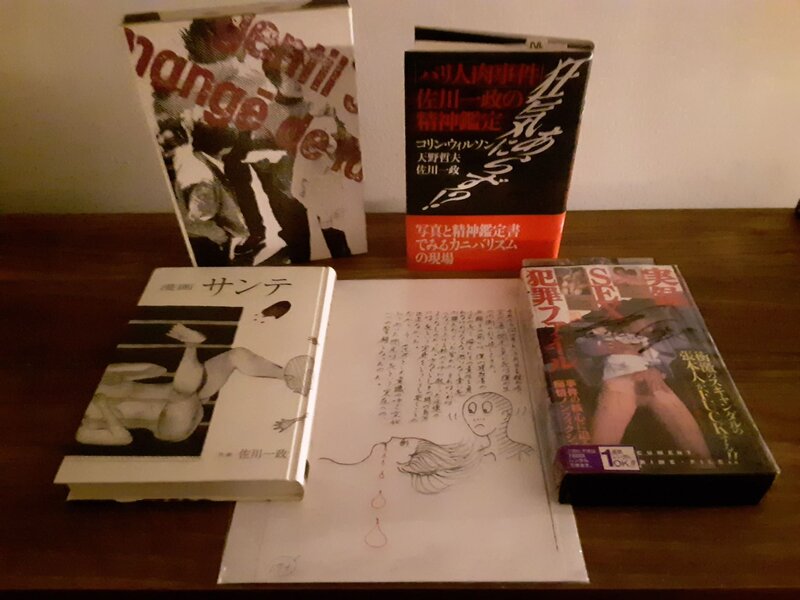Create a free profile to get unlimited access to exclusive videos, breaking news, sweepstakes, and more!
What is Murderabilia? The Strange Allure Of Artifacts From Serial Killers, Explained
An entire secret industry revolves around the sale of artificats from serial killers. But is it moral to collect these accursed objects? We talk to an artist, a historian, and a victim advocate about the ethics of murderabilia.
When you were shopping for Christmas presents this year, you probably didn't browse through paintings by John Wayne Gacy or try to get your hands on Richard Ramirez's windbreaker. But for some people, these kind of serial killer artifacts are must-have items.
The mysterious allure of serial killers and mass murderers has led to the creation of an entire clandestine industry in which dealers trade items created by and from criminals, and sometimes, the cost of these nefarious goodies, nicknamed "murderabilia," reaches astronomical prices. The history and scope of the murderabilia industry remains shrouded in mystery: These operations exist largely through underground channels which are sometimes kept heavily hidden, with information spread through whisper networks and closely guarded groups.
How dealers come to possess these items and the extent to which the market is flooded with fakes remain huge questions for investigators and buyers alike. Plus, the status of these ghastly keepsakes remains in a legal gray area, with some activists fighting for the eradication of the entire industry. But why do people want these accursed items, anyway?
Original Artwork by serial killer John Wayne Gacy during John Wayne Gacy - Original Artwork Exhibition at Club USA at Club USA in New York, New York, United States. [Photo by Steve Eichner/WireImage/Getty Images]
One of the most notorious “subjects” of murderabilia is cult leader Charles Manson. After his death in late 2017, a legal battle for the notorious criminal's body waged on, some worried that parts of his corpse and his personal effects would find their way into illicit markets. Items including a voodoo doll he reportedly made in prison and his dentures had previously been listed at prices ranging from $4,000 to $10,000. In fact, the public's enduring fascination with Manson's belongings has led to him getting dubbed the "King" of murderabilia.
Dementia Von Grimm, a U.K.-based gothic drag performer who keeps written correspondences with at least one serial killer, spoke to Oxygen.com about their interest in murderabilia.
“Let's just say, I would liken my childhood to Wednesday Addams. I always searched out the more macabre subjects in life," explained Von Grimm. "[When I was young] I came across a book called 'The A to Z of Serial Killers.' I read each case. It just spoke to me. I have an interest in the human monster, and the psychology of what the human mind is capable of doing.”
Grimm's interest in the morbid led them to several secret Facebook groups, where adoring fans would fight over both affection and literal objects from their most beloved murderers.
"There are literally wars between these people over [these objects]. I've met every kind of individual you can think of in these groups from psychopaths to necrophiliacs... There's some like me who are interested in the psychology of these people. For others it is literally a fetish. I've met many different types of men and women who are turned on by these people — some of them turned on by the thought of being murdered. You meet every demographic in that community. And there's some that are just doing it to lean into the edgelord part of it — the shock value. It's a new version of being a Marilyn Manson fan to upset your parents.”
The trading described by Von Grimm is precisely the kind of activity Andy Kahan, a Texas-based victim advocate who originally coined the term murderabilia, is trying to criminalize out of existence.
"I'm of the perspective that you shouldn't be able to rob, rape, and murder and then turn around and make a buck off of it. It's that simplistic," Kahan told Oxygen.com. "I'm a firm believer in free enterprise and capitalism but I think you have to draw the line somewhere."
Kahan's descent into the depths of murderabilia began in 1999, when he read the story of a killer's art privileges being revoked after officials discovered he had been selling his works on eBay — a practice banned by the site in 2001. From there, Kahan began investigating how widespread this phenomenon really is.
“Like it or not, it's human nature that people are going to be fascinated with the macabre. You have an entertainment industry that basically revolves around one word: murder. When you look at the books, the movies, have you ever seen a bio about a crime victim? We all know who these killers are, they're household names. They're given infamy and immortality."
Kahan finds himself in a precarious legislative position in his quest: How does one clamp down on these dealings without encroaching on these criminals' right to free speech?
"My reality is trying to craft [legal] language that will withstand constitutional muster," he explained. "I think most people would agree with me: You shouldn't profit from criminal conduct. We're targeting tangible goods that are actually produced by the killers themselves that are sold at an open market. I took on this project because I was frankly just appalled and no one knew about it. I decided to make it an issue."
Kahan's journey through the annals of murderabilia led him to collecting his own menagerie of bizarre products, which he presents at lectures and workshops to raise awareness of the situation.
“You gotta have a sense of humor doing this," Kahan said through laughter. "I actually put together a 'Top 10 Most Bizarre Items I've Found' list. The number one used to be foot scrapings from The Railway Killer — that's now number 2. That was replaced by — I'll delicately put it to you like this, bodily fluid deposited on a scantily clad photo of a female from a Massachusetts school shooter who I'll leave unnamed for the moment.”
Perhaps the strangest facet of Kahan's story is his partnership with serial killer David Berkowitz. (Ironically, a law which prevented criminals from profiting off of their publicity that was struck down by the Supreme Court in 2000 had been named after the Son of Sam.)
Years into researching the subject, Kahan had sent out surveys to 20 notorious killers asking about the sale of their materials, realizing that many may not have even known their personal effects were being made available for purchase. Kahan received 12 responses, the most enthusiastic of which came from Berkowitz.
"He has been one of the most reliable, trustworthy assets I could have never dreamed of. We've been going back and forth now about 15 years about this. It's a strange alliance! So what David would do is: Whenever he would get solicitations from dealers, he would ship them all to me. There was a company in Ohio that at one time was developing serial killer greeting cards. They sent Berkowitz prototypes wanting his approval and he just shipped the entire packet to me. It's almost like a grooming, very similar to sex offenders. They say to the killers, 'I got a business we can both benefit from.'”
But do the items Kahan is trying to prevent from entering the market have any inherent value beyond the prurient?
Writer Michal Bajer, a historian currently working on a book about little-known Polish serial killers, recognizes the controversy surrounding murderabilia but instead invites his audience to consider the socio-historic value of these bizarre curios.
"I was very much into history growing up, American history particularly," Bajer told Oxygen.com. "The first period of interest for me was the Wild West — of course I was interested in the gunmen and the outlaws. From there it was the gangsters of the prohibition era. And then I started drifting to modern organized crime and mobsters, and my last stop was serial killers.”
Bajer began hunting for his own murderabilia when he started offering tours on the history of American serial killer Albert Fish, a particularly nasty rapist and cannibal who took the lives of several children between 1924 and 1936. (Bajer's tour is currently on hold until his aforementioned book is completed.)
“Albert Fish is the jewel of my crown, so to speak — which is a bit strange to say," explained Bajer. "When I first read about him, I thought I must have been taken for a ride or there had been some mistake. The more I read about him, it seemed like a case of horror writer one-upmanship — like a bunch of 14-year-olds sitting around asking, 'What's the next disgusting thing we can do? Oh he shoved needles in him! Ate kids!' I thought, 'This is ridiculous. This is insane.' Sadly life ultimately verified that someone like that did exist. So I started digging deeper into Albert's life. I just had to consume more and more information about him.”
"My point was never to exploit or make it sensationalized — even though the material of the story is obviously horrific. I wanted to showcase and to educate," Bajer continued. "Maybe to transport us to that time. I wanted to go about it in a way that was as legal as possible. I didn't take any money from the tour. I funded everything out of my own pocket down to the gas money. So it wasn't a case of me trying to get a few people and show them some cheap thrills. I do this out of the passion to share the historical and the macabre.”
Bajer is relatively new to the acquisition of actual artifacts, although he has come to own several pieces by the Japanese cannibal Issei Sagawa.
Drawings and manga by Japanese cannibal Issei Sagawa, owned by historian Michal Bajer.
But Bajer presented a much different picture of the dealers and collectors he met in secret social media groups.
"I was expecting it to be sort of a bizarre, strange place but the murderabilia groups that I'm a part of, a lot of the people are very respectful and very kind. The only difference, I suppose, is that the items that I'm looking for are either nonexistent or beyond pricey. Someone did claim to have a needle found in Albert Fish's body that they were selling for $30,000, but it was proven to be a fake. So you get the occasional scammer, someone trying to make a quick buck. But for the most part the people I've met and talked to have been extremely kind.”
Bajer emphasized that while he has contemplated the moral conundrum murderabilia presents, he still thinks of these items as important relics.
"I understand why it rubs a lot of people the wrong way and why there's a push against it," he said. "The problem is that I know a lot of collectors, myself included, that approach it from a different angle and we try to go about it as — well, humanely is the wrong word — but in a more acceptable way.”
The extent to which murderabilia presents a moral conflict remains a dilemma for true crime enthusiasts looking to own a tanglible piece of their sinister hobby. And while debates about the ethics of murderabilia rage on, both advocates for and opponents of the industry agree that interest in the darkest parts of the human psyche is essentially inevitable. Whether the actual objects of murderers gives us any insight into this subject is another question entirely.
[Photo: Charles Manson via Getty Images]
































